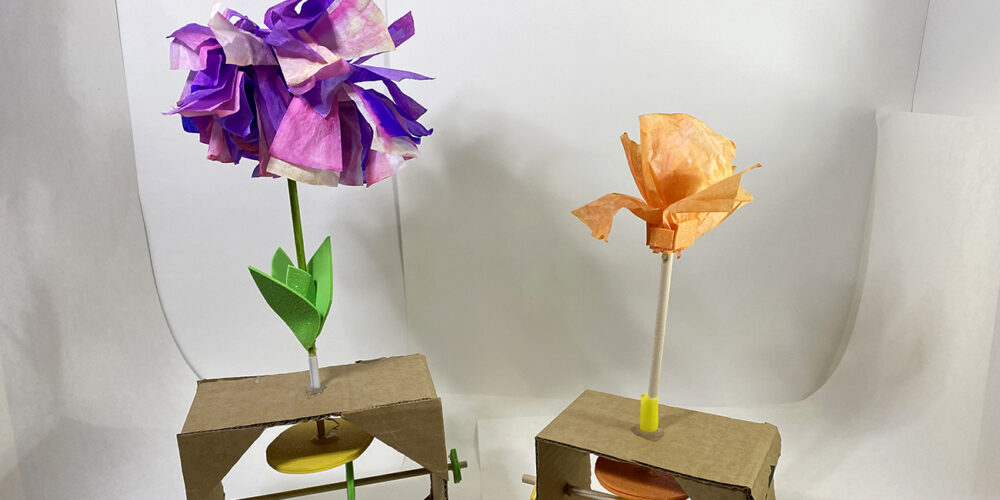The Great Rivers Biennial 2020 artist Rachel Youn created the sculpture installation Gather out of pre-owned materials they found or purchased on internet sites like Craigslist or Facebook Marketplace. Electric massagers, plastic plants, old stereo speakers. Youn made these abandoned items into kinetic sculptures–moving objects that whirl, sway, and dance. Using cardboard and a chromatography technique on coffee filters, let’s make our own hand-operated moving artworks.

For ages: 10 years–Adult
Time it takes: About 60 minutes
What we’re going to do:
- Build a kinetic sculpture that moves, using simple materials.
- Use a form of chromatography to create a watercolor or tie-dye effect with markers.
- Experiment with different materials and tools to explore new things about art and design.
You’ll need:
Coffee filters
Water-based markers
Water in spray bottles or a droplet bottle
An unfolded paper clip
A 30 inch x 3 inch piece of cardboard
Extra cardboard to make 4 to 8 triangles to stabilize
Glue gun
Scissors
Wooden skewers or sticks/small round dowels
Straws (paper or plastic)
1–2 sheets thick foam, 6 x 9 inch sheets (6mm or 3 mm)
Before we start:
Let’s watch a video and look at images of Rachel Youn’s installation Gather.
Think about:
- How would you describe the mood of this installation?
- Does the installation remind you of anything?
- What do you think was the artist’s inspiration?
- Can you describe some of the movements the flowers and plants are making, either with words or with your own body?
Art Activity
To make the flowers:
- Cover work tables with plastic, or use cookie sheets, plastic trays, or sturdy paper plates.
- We’re going to use a process known as chromatography: a process of separating with color by using water to separate marker ink. Each sculpture needs 3–4 coffee filters. Play with the amount of ink you use, both small and large amounts, and see what happens.
- Before you apply water, think about how the color will spread. You don’t need a lot, only a couple of droplets or a few mist from a spray bottle.
- After the filters are dry, attach them to the top of a skewer or dowel to make a flower. To help stabilize the coffee filter, a small square piece of foam can be poked through the top of the skewer/dowel. Attach the coffee filter with the glue gun. Make leaves with leftover foam, and use a paint pan or marker to color the top of the skewer/dowel.

To make the machine base:
- Fold the strip of cardboard into a square, leaving 6 inches on each side. Use the glue gun and glue down any overlap. Stabilize the square by cutting extra cardboard into 4–8 triangles and attach them to the corners using the glue gun. The more triangles used, the sturdier the square—at least two squares at opposite corners on each side. If more visual information is needed, watch this video from the The Tinkering Studio.

- Next, make the cam, the spinning element that is turned with the handle on the axel, and the cam follower, which sits on top of the cam and allows the flower to spin. For reference, the images below show the cam in yellow and the cam follower in orange. Trace a circular or oval shape on the thick foam for each piece, making sure the cam follower is larger than the cam.

- Poke the cam through the skewer or dowel. Use a nail or straightened paper clip to make a hole in the center of the cardboard frame. Once it’s pushed through both sides of the frame, cut one small foam or cardboard square and push on the outer cardboard frame. This stabilizes the axel, the skewer/dowel with the cam in the center.

- Create a handle by gluing a small rectangle cut from the cardboard to the skewer/dowel axel on the extra end. Glue the second piece of skewer/dowel to the rectangle’s end to form a handle.

Terms:
Chromatography
Kinetic Sculpture
Installation Art
Clean Green Floral Machine is inspired by Rachel Youn: Gather, Great Rivers Biennial 2020. The activity has been adapted from the Cardboard Automata project at the Exploratorium’s Tinkering Studio.
